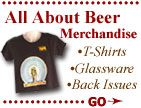
| ||||
| AAB Departments |
| ...Beer Features |
| ...Beer Talk |
| ...Pull Up A Stool! |
| ...What's Brewing |
| ...Beer Travelers |
| ...Stylistically Speaking |
| ...Beer & Food |
| ...Homebrewing |
| ...Collectibles |
| ...Marketplace |
| Beer Lovers' Resources |
| ...World Beer Festival |
| ...Brew Cruise Info |
| ...AAB Merchandise |
| ...AAB Bookstore |
| ...Beer Links |
| About the Magazine |
| ...Subscription Info |
| ...Retail the Magazine |
| ...Advertising Info |
| ...Contact AAB |

|
All About Beer Magazine
Volume 23 Number 2
March 2002
Back Bar Advertising
by Dave Gausepohl
 Marketing departments have known for years that effective selling is all about real estate, and the most important factor is location, location, location. What better place to saturate the consumer with a brewery's image than on premises in a location near the beer tender. The backdrop or "back bar" area behind the server of the suds is the beer advertising location of choice.
Marketing departments have known for years that effective selling is all about real estate, and the most important factor is location, location, location. What better place to saturate the consumer with a brewery's image than on premises in a location near the beer tender. The backdrop or "back bar" area behind the server of the suds is the beer advertising location of choice.
Because the demand for back bar advertising has always been great, breweries have created what might be called the piece de resistance for collectors of beer memorabilia to adorn this stretch of real estate.
These pieces of breweriana--back bar advertisements--are truly some of the most sought after by collectors. Some of the most notable are chalk statues and figurals made of plaster of Paris reinforced with horsehair. These really helped a brand get noticed at the source. Some of the chalk items were designed as wall hangings as well, allowing for more placement flexibility.
The bar was not always the best placement in every on premises establishment. Most back bars had a mirror built into them. The mirror made the wall space across from the bar a double whammy. You had the benefit of a dual visual effect.
After World War II, plastic became a more popular material for these pieces. In the technology's infancy, the early plastics were a crude material. Bakelite, melamine and early forms of fiberglass were put to the test in this visual form of advertising.
A more universal idea for use of the plastic materials can be seen in that "leg lamp" that Darin McGavin treasured in the movie, "A Christmas Story." Some of the beer ad items would even be lit from inside like the leg lamp.
The chalk sculptures have stood the test of time better than these early plastic pieces of brewery art. It really wasn't until after "The Graduate" that plastics evolved into the profitable staple they are today. Of course, other materials, such as cast iron and cast aluminum, could be used to craft bar advertising statues and display pieces.
Another great back bar item was the display bottle. These were usually between two and three feet tall and were just large replicas of the package being served at the bar. Made of glass as well as plastic, the advertising bottles were used to introduce a new design or look to the brand. This way the patrons could become familiar with the new appearance while enjoying their familiar brand. A myth that persists today is that because the outer package changed somehow, the liquid contents must also have gone through a redesign.
The power of suggestion has always played a major role in how we sell beer. As you can see from the various types of back bar advertising, the suggestion was more often visual than verbal. The next time you are in your local drinking establishment, take a good look around. There may not be words on the ice cubes, but there will be plenty of subliminal selling going on.
Beer Dave Gausepohl has collected breweriana since 1974 and has a personal collection of over 400,000 items. He has visited over 1,000 breweries and tasted well over 10,000 different brews from the world over.
----------------------------
Beer Dave Gausepohl has collected breweriana since 1974 and has a personal collection of over 400,000 items. He has visited over 1,000 breweries and tasted well over 10,000 different brews from the world over.









